The Top 15 Richest Counties in Virginia: From Pasture to Prosperity
Virginia, known for its rich history and scenic landscapes, is also home to some of the wealthiest counties in the United States. The Old Dominion State boasts a diverse and thriving economy, contributing to the financial success of its counties. In this listicle, we’ll explore the top 15 richest counties in Virginia based on their median household income as of 2021. From the verdant landscapes of Loudoun County to the urban sophistication of Arlington, these counties showcase prosperity in various forms. So, let’s delve into the opulence that Virginia has to offer.
15. Chesterfield County
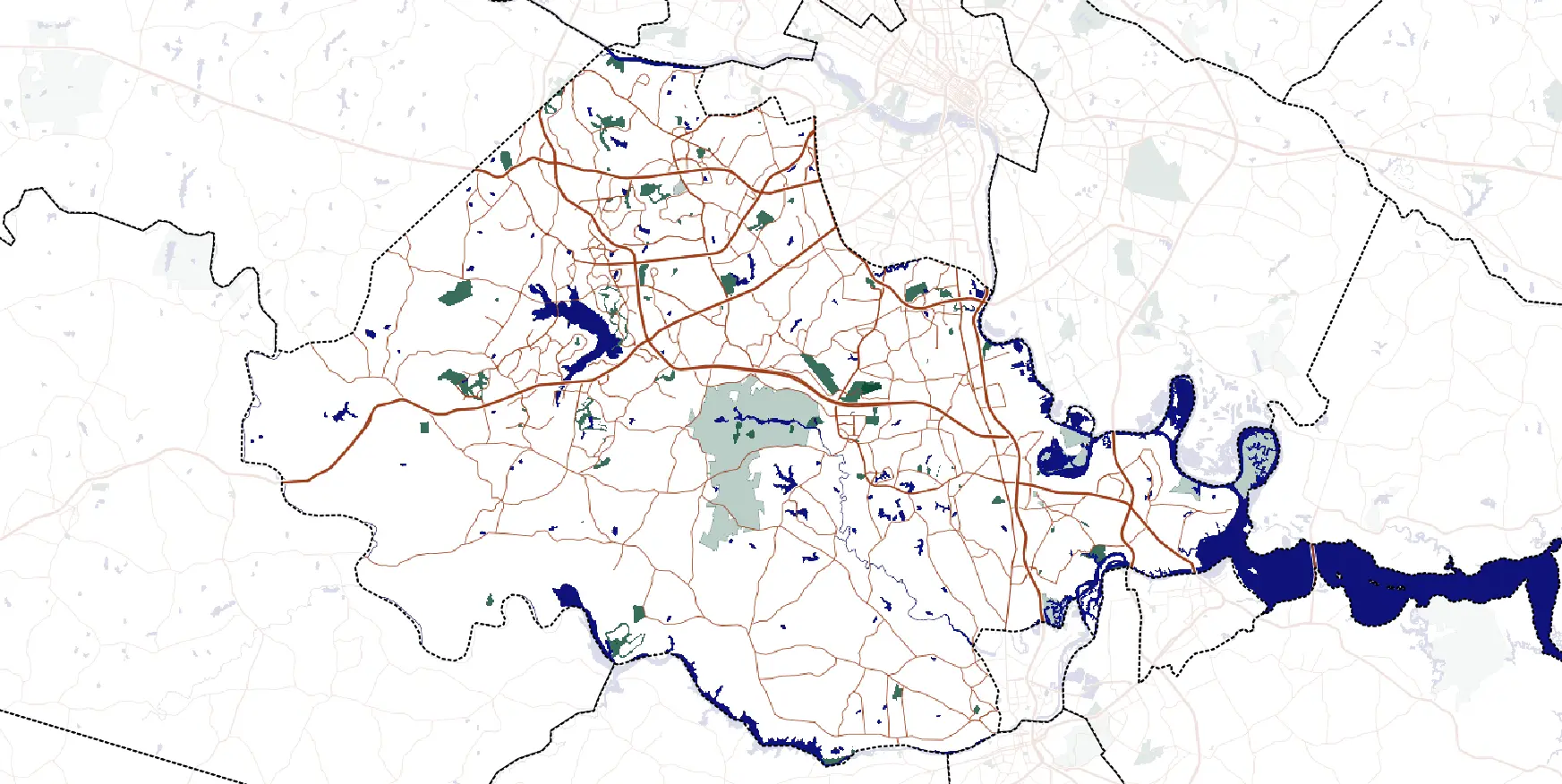
Median Household Income: $71,321
Historical Insights: Chesterfield County, our 15th-ranked wealthy county, is steeped in history dating back to the early 17th century when it was established. Originally, the county’s economy was predominantly agrarian, with tobacco cultivation playing a vital role. However, with the passage of time and the advent of the 20th century, Chesterfield began to transform. The construction of the Richmond and Petersburg Railroad in the mid-19th century marked a pivotal moment in the county’s economic development. This strategic rail connection spurred industrial growth and urbanization, setting the stage for the diverse economy that Chesterfield County enjoys today.
Economic Evolution: Chesterfield County’s economic evolution is a remarkable journey from its agricultural roots to a thriving modern community. In the mid-20th century, a shift towards manufacturing, particularly in the transportation and manufacturing industries, bolstered the local economy. The establishment of major businesses, retail centers, and educational institutions has further stimulated growth. Today, the county boasts a robust economy with a diverse job market, including healthcare, education, manufacturing, and technology sectors. The median household income of $71,321 reflects this transformation, showcasing a prosperous blend of historical charm and contemporary opportunities.
Current Economic Landscape: In the current economic landscape, Chesterfield County continues to grow and diversify. The county’s strategic location near the capital city, Richmond, has attracted various businesses and residents seeking a blend of urban amenities and suburban tranquility. The thriving healthcare sector, strong manufacturing base, and a focus on educational excellence contribute to its residents’ economic well-being. With a continued commitment to economic growth and innovation, Chesterfield County is a prime example of how a historically rich area has adapted and thrived in the modern era.
14. Clarke County
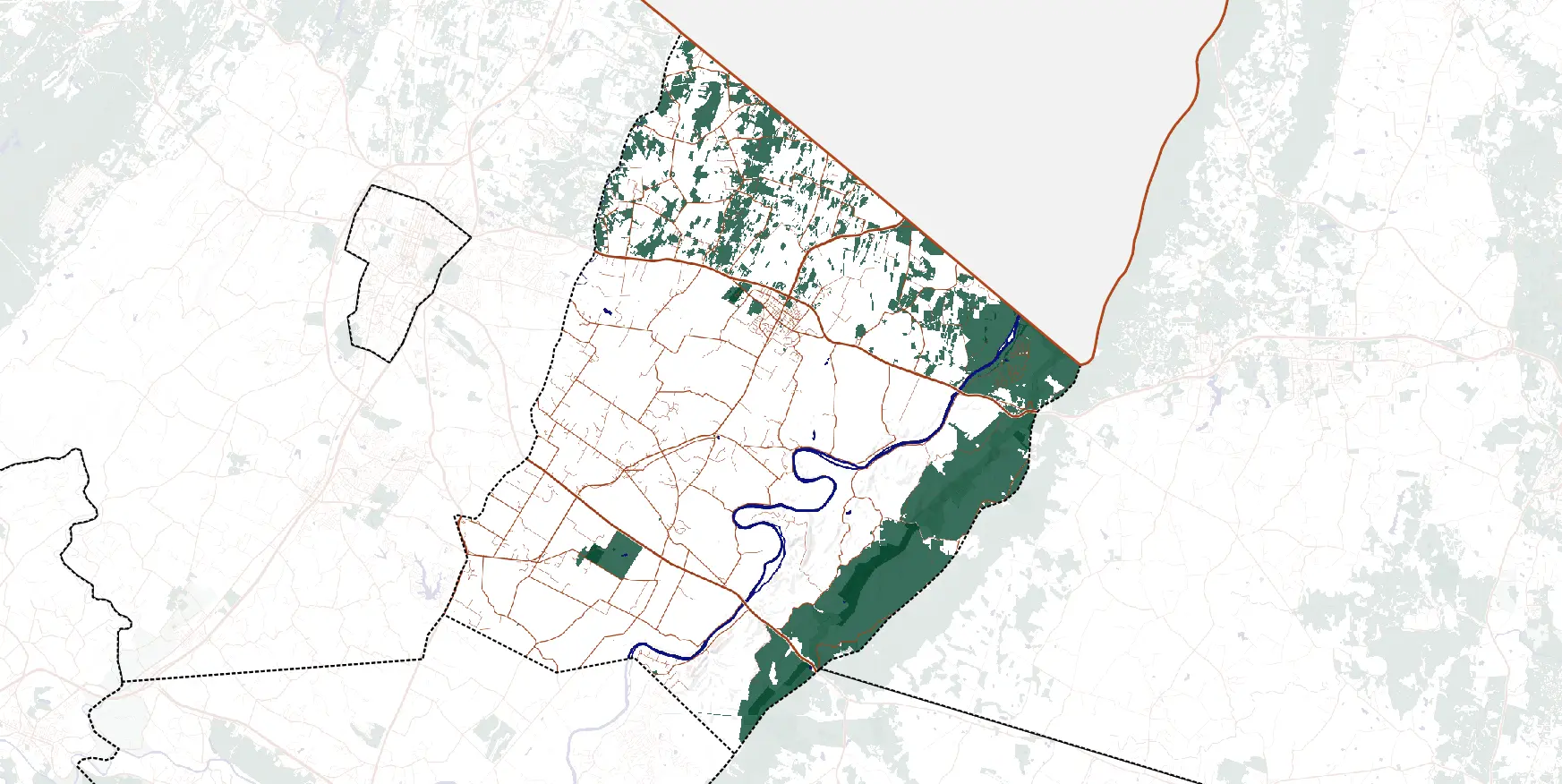
Median Household Income: $73,244
Historical Insights: Clarke County, nestled in the northern reaches of Virginia, traces its roots to the early 18th century. Initially, agriculture was the bedrock of its economy, with farms and plantations dominating the landscape. The county’s fertile soil made it ideal for crop cultivation, and grain and livestock farming were cornerstones of its early economic development. Over time, the construction of the Winchester and Potomac Railroad in the 19th century played a pivotal role in connecting Clarke County to broader markets and facilitating the transport of goods.
Economic Evolution: Clarke County’s economic evolution has seen a gradual shift from an agrarian society to a residential haven. While agriculture still plays a role, the county’s proximity to Washington, D.C., and Northern Virginia has attracted a new wave of residents and businesses. The rise of tourism, particularly related to its natural beauty and historical sites, has contributed to the local economy. This evolution, coupled with responsible urban planning, has led to a median household income of $73,244, reflecting the balanced blend of tradition and modernity.
Current Economic Landscape: Clarke County’s current economic landscape reflects a balanced coexistence of its rich historical heritage and contemporary developments. Its location, offering a rural lifestyle within commuting distance of urban centers, has become a valuable asset. Tourism remains a key industry, drawing visitors to its picturesque landscapes and quaint towns. Clarke County stands as a testament to how historical charm and responsible growth can create an economically thriving community in the present day.
13. Powhatan County
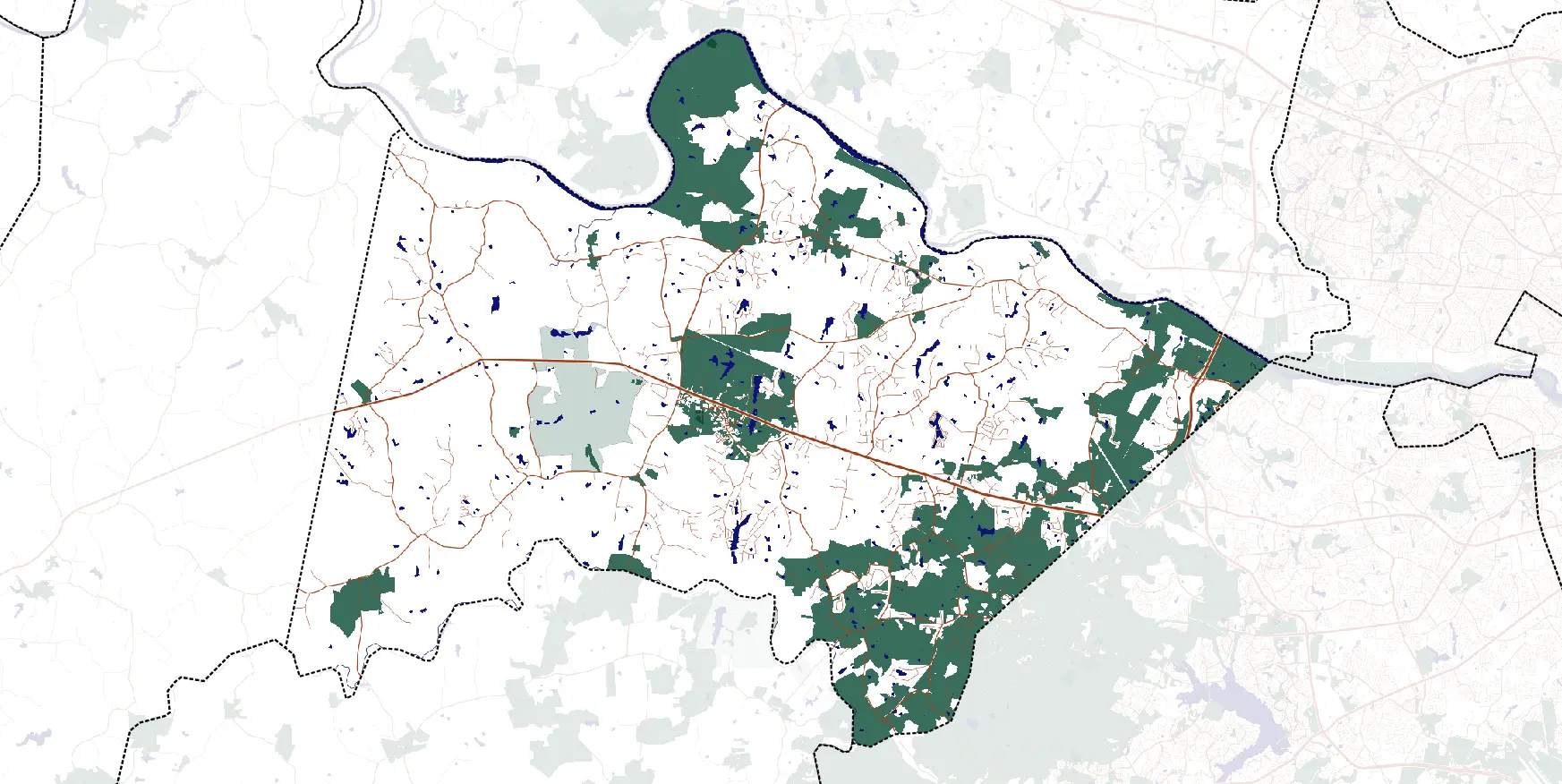
Median Household Income: $73,593
Historical Insights: Powhatan County, named after the famed Native American chief, traces its history to the early 18th century. Initially, the county’s economy revolved around agriculture, with tobacco, corn, and wheat as primary crops. The fertile lands along the James River provided the foundation for a thriving agricultural community. Powhatan’s economic history is also intertwined with the development of the Richmond and Danville Railroad in the 19th century, which facilitated trade and transportation, opening up new economic possibilities for the region.
Economic Evolution: Over time, Powhatan County’s economy transitioned from a predominantly agrarian society to a more diversified landscape. While agriculture remains a significant part of the local economy, the county has embraced growth and modernization. The county’s strategic location, just west of Richmond, has attracted residential and commercial development. This shift towards suburban living, coupled with responsible planning, has contributed to a median household income of $73,593, showcasing a balance between rural traditions and economic progress.
Current Economic Landscape: In the present economic landscape, Powhatan County continues to maintain its rural charm while embracing economic growth. The county offers a high quality of life for its residents, blending countryside living with access to urban amenities. Its growing healthcare sector, educational institutions, and vibrant small businesses contribute to the community’s economic well-being. Powhatan County stands as a prime example of how a historically agricultural area can adapt and flourish in a contemporary world.
12. James City County
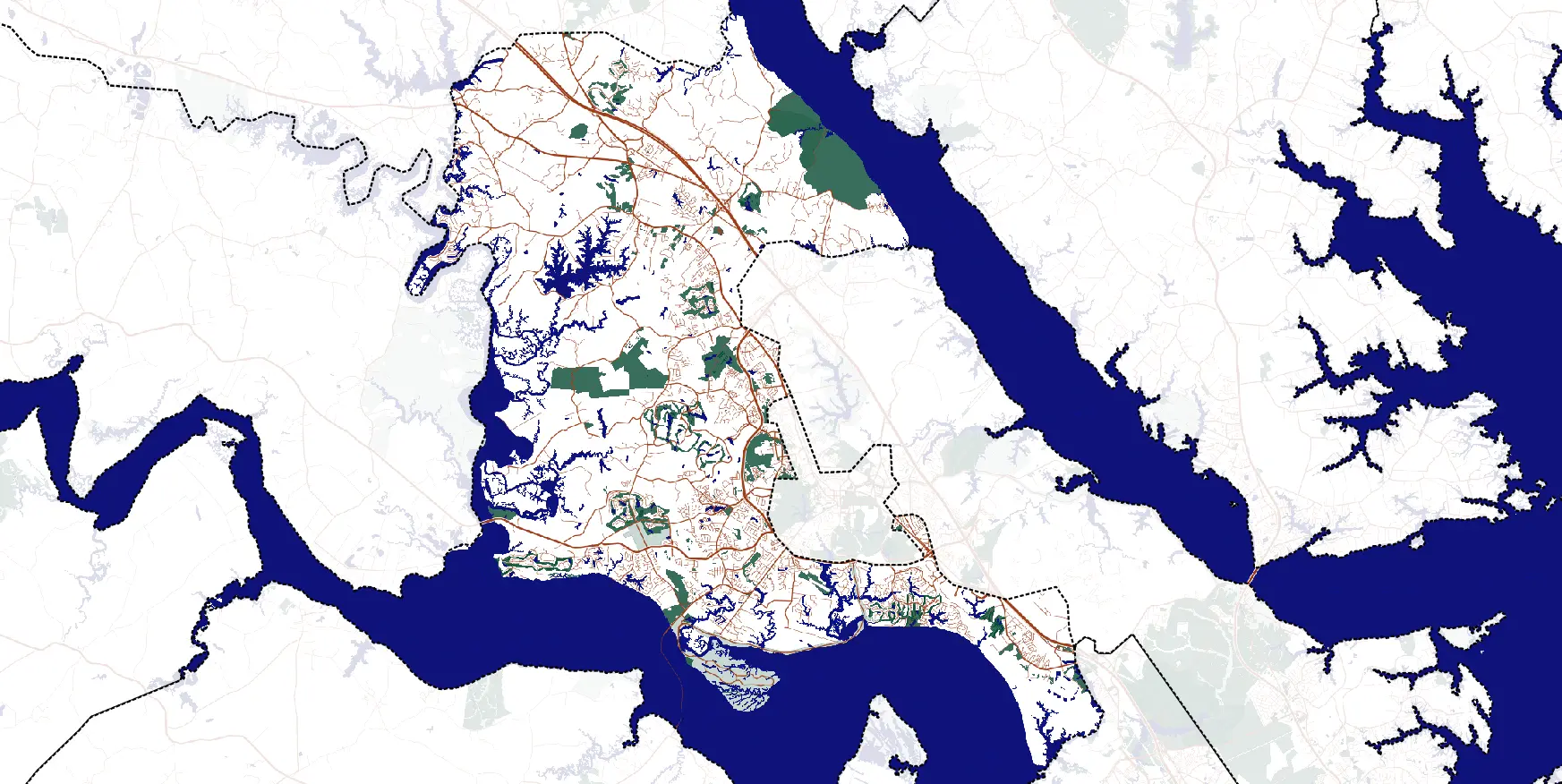
Median Household Income: $73,903
Historical Insights: James City County’s history dates back to the early 17th century when it was established as one of the original eight shires of Virginia. With a location near the Jamestown settlement, it played a pivotal role in early colonial history. Its economy, initially reliant on agriculture, particularly tobacco cultivation, began diversifying as the county developed. The establishment of Jamestown as an English settlement marked the county’s initial economic focus on trade and commerce, which eventually led to its growth.
Economic Evolution: James City County’s economic evolution is a testament to its historical significance. As the county continued to develop, it expanded its economic activities beyond agriculture to include tourism and education. The establishment of the College of William & Mary in 1693 laid the foundation for a thriving educational sector. Additionally, the county’s proximity to Colonial Williamsburg, a living history museum, fueled tourism. In recent years, the county’s strategic location, nestled between Richmond and the Hampton Roads metropolitan area, has attracted various industries, including healthcare and technology. The median household income of $73,903 reflects the diversity and growth that James City County has embraced over the centuries.
Current Economic Landscape: In the present economic landscape, James City County remains a historical gem that has successfully combined its rich past with modern economic opportunities. Tourism continues to thrive, drawing visitors from all over the world to experience the county’s historical attractions. The presence of the College of William & Mary contributes to an educated workforce, attracting tech and research-related businesses. The county offers residents a unique blend of cultural heritage and economic advancement, making it a place where history and progress walk hand in hand.
11. King George County
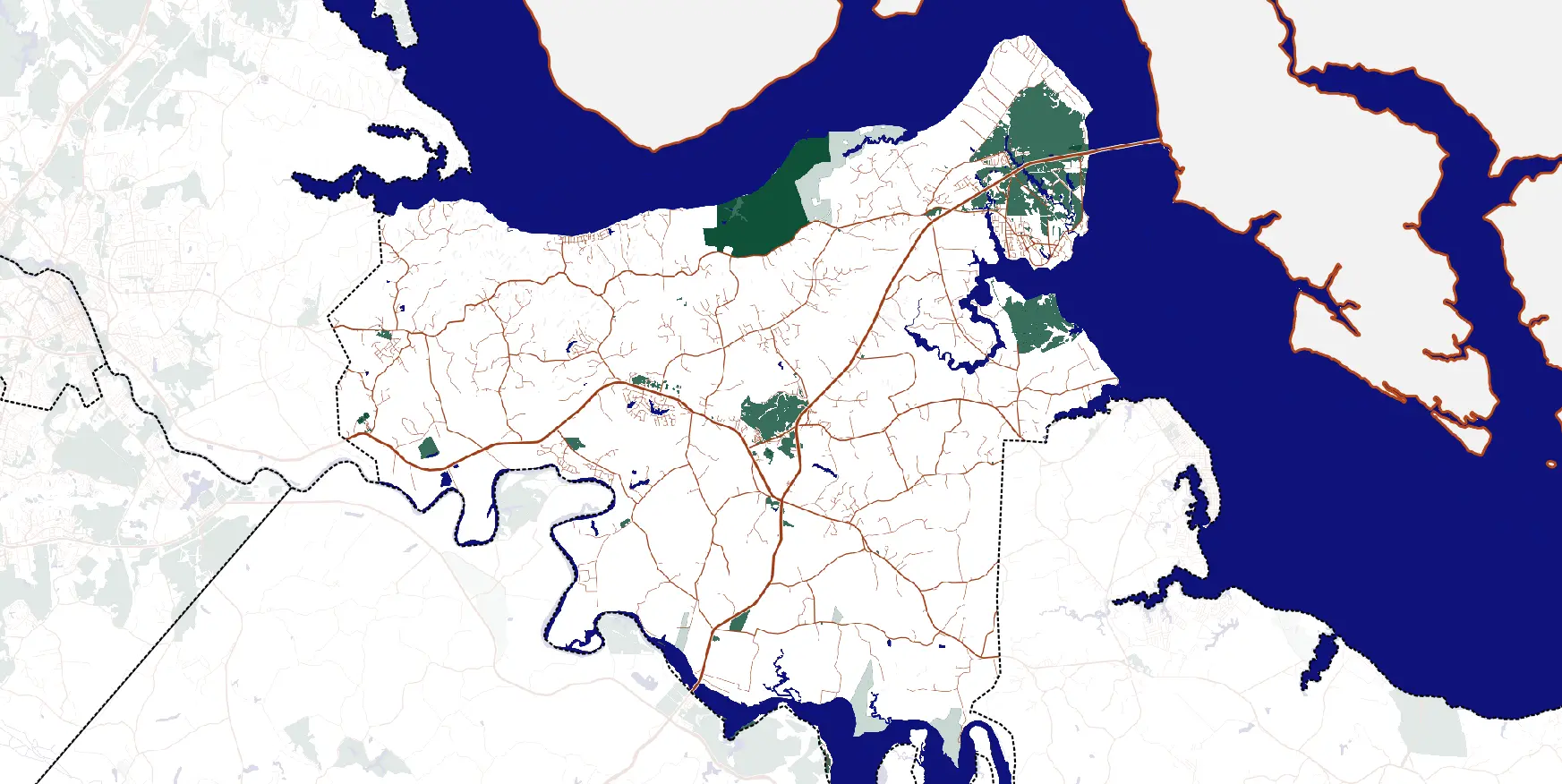
Median Household Income: $76,241
Historical Insights: King George County, established in the early 18th century, takes its name from King George I of England. Historically, the county’s economy was centered around agriculture, particularly tobacco cultivation. The navigable waters of the Potomac River allowed for trade and transportation, and the county’s early growth was fueled by its proximity to this vital waterway. Over time, the establishment of the naval base at Dahlgren brought new economic opportunities to the area.
Economic Evolution: King George County’s economic evolution witnessed a shift from an agricultural focus to a more diverse landscape. The presence of the Dahlgren naval base, established during World War I, had a transformative impact on the county. It not only provided employment opportunities but also attracted various support industries, contributing to the local economy. Today, the county’s location, nestled between the Potomac River and the Rappahannock River, offers residents a balance between waterfront living and access to urban amenities. With a median household income of $76,241, King George County represents a harmonious blend of historical significance and modern economic development.
Current Economic Landscape: In the current economic landscape, King George County continues to benefit from its strategic location and the presence of the Dahlgren naval base. The county’s commitment to economic diversification, including tourism, healthcare, and educational services, has created a vibrant and thriving community. The county’s rich history, combined with contemporary economic opportunities, positions King George County as a prime example of how historical areas can adapt and flourish in the present day, offering a high quality of life for its residents.
Please let me know if you would like me to continue with the descriptions for the remaining counties.
10. Hanover County
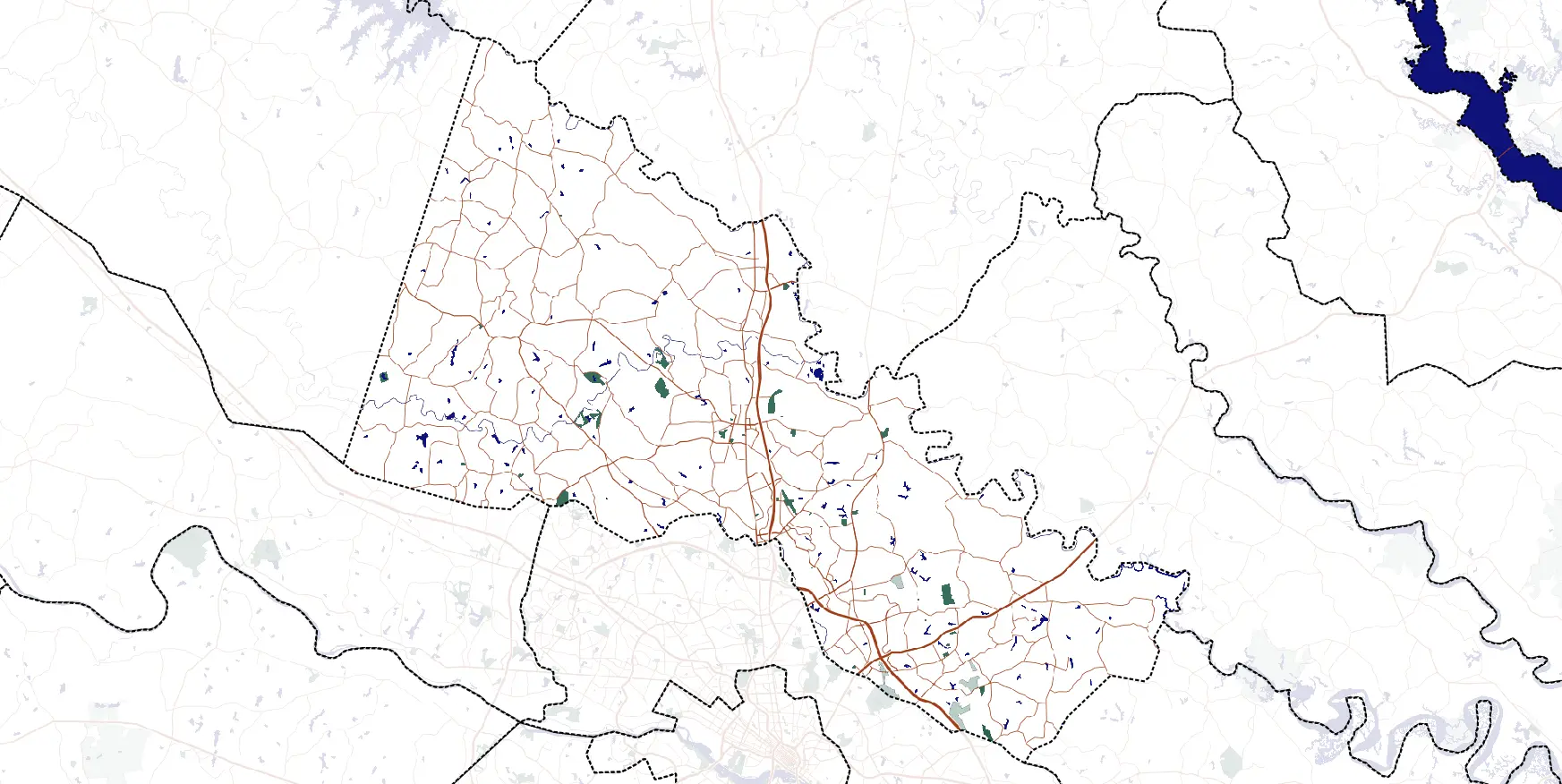
Median Household Income: $76,425
Historical Insights: Hanover County, established in the early 18th century, has a rich history rooted in agriculture. Tobacco was a significant crop in the county, and its fertile soil contributed to agricultural prosperity. The county’s economy was also influenced by the development of the Richmond and Fredericksburg Railroad in the 19th century, connecting it to broader markets and facilitating trade.
Economic Evolution: Hanover County’s economic transformation has seen a shift from an agricultural-based economy to a more diversified landscape. While agriculture remains a part of the local economy, the county has embraced growth and modernization. Its proximity to Richmond, the state capital, has made it an attractive destination for residential and commercial development. This transition, combined with a strong commitment to education and community, has contributed to a median household income of $76,425, reflecting the harmonious coexistence of rural heritage and economic progress.
Current Economic Landscape: In the present economic landscape, Hanover County thrives as a growing community that blends historical charm with economic prosperity. The county is known for its strong education system, local businesses, and a vibrant healthcare sector. It offers residents a balanced lifestyle where they can enjoy the tranquility of the countryside while having access to the opportunities of a dynamic economy. Hanover County exemplifies how a historically agricultural area can adapt and flourish in the modern era.
9. Spotsylvania County
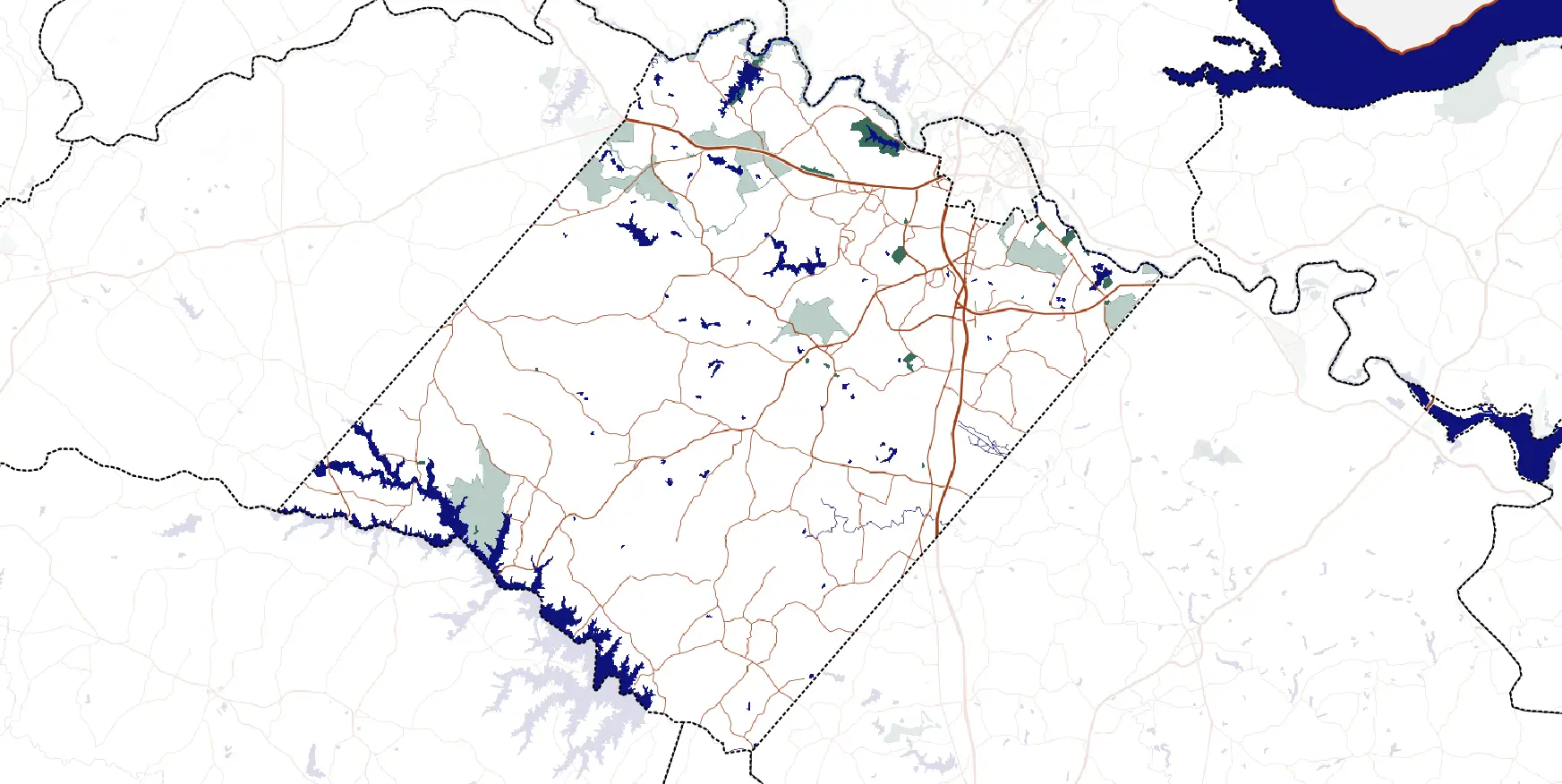
Median Household Income: $76,574
Historical Insights: Spotsylvania County, with its origins dating back to the early 18th century, has a historical foundation rooted in agriculture and trade. The county’s agricultural economy was influenced by tobacco farming, and it became a key player in trade and commerce due to its location along major transportation routes.
Economic Evolution: Spotsylvania County’s economic evolution has seen it transition from its agricultural heritage to a diversified modern economy. The county’s strategic location, nestled between Richmond and Northern Virginia, has attracted businesses and residents seeking a blend of suburban living and urban opportunities. The growth of sectors like healthcare, education, and retail has bolstered the local economy. With a median household income of $76,574, Spotsylvania County showcases a blend of historical significance and contemporary prosperity.
Current Economic Landscape: In the current economic landscape, Spotsylvania County continues to flourish. The county offers a high quality of life with strong educational institutions and healthcare services. Residents enjoy the advantages of both rural and suburban living, making it an appealing place for professionals and families alike. Spotsylvania County stands as a testament to how historical areas can adapt to the changing times and thrive in the modern era.
8. Goochland County

Median Household Income: $79,574
Historical Insights: Goochland County, with its establishment in the early 18th century, has a history intertwined with agriculture, particularly tobacco farming. The county’s economy prospered due to its fertile lands and river access, which facilitated trade and transportation.
Economic Evolution: Goochland County’s economic evolution has witnessed a transformation from its agricultural roots to a more diversified and modern economy. The county’s proximity to Richmond has attracted businesses, industries, and residents. Today, Goochland County hosts a thriving healthcare sector, educational institutions, and a growing tech industry. With a median household income of $79,574, the county reflects a successful blend of rural heritage and economic progress.
Current Economic Landscape: In the present economic landscape, Goochland County continues to evolve as a thriving community. Its economic diversification and strategic location make it an attractive place for those seeking a blend of suburban living and economic opportunity. The county’s commitment to quality education and community development further contributes to its residents’ well-being. Goochland County exemplifies how historical areas can adapt to contemporary demands and offer a high quality of life for its residents.
Please let me know if you would like me to continue with the descriptions for the remaining counties.
7. York County
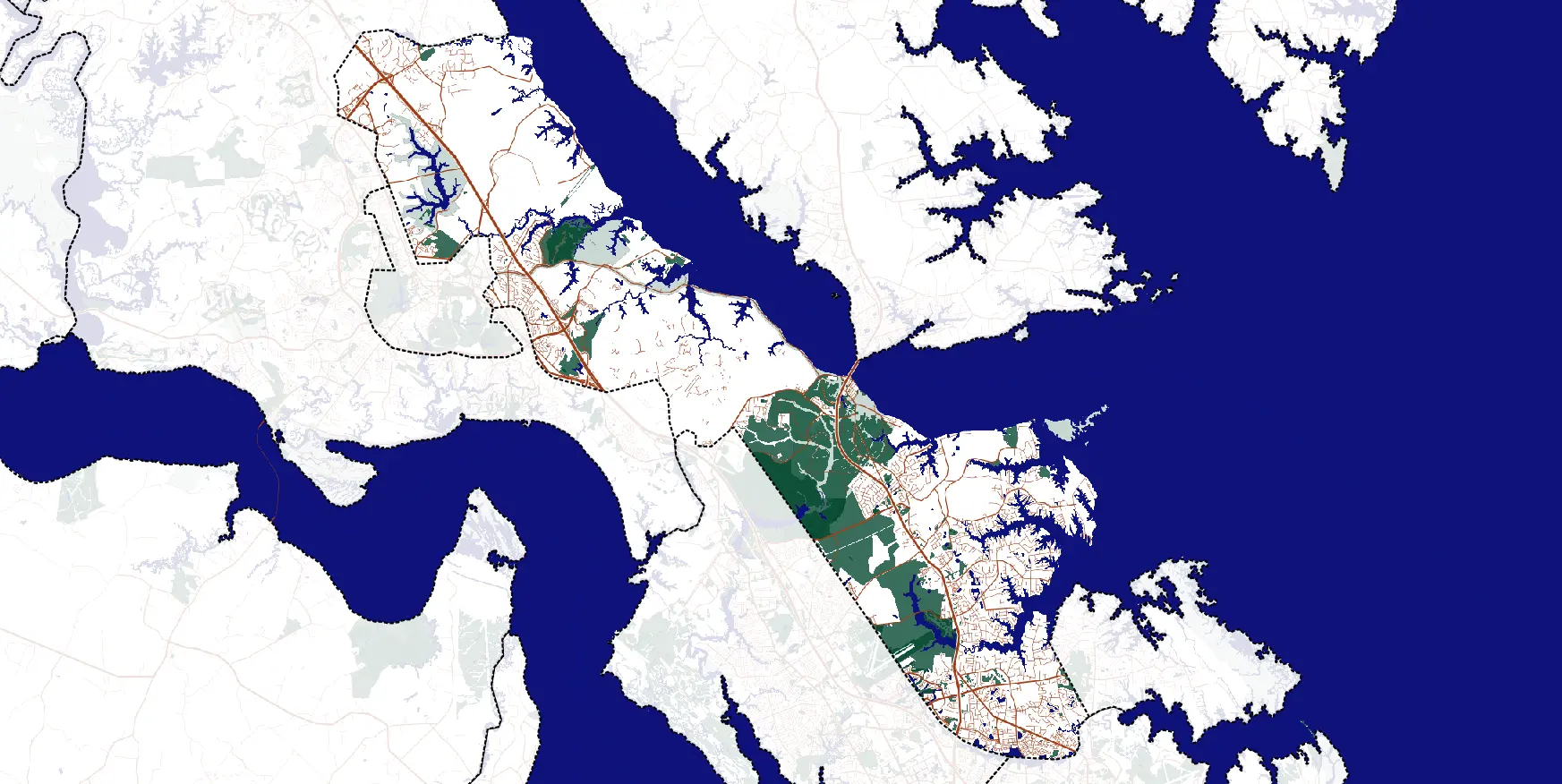
Median Household Income: $81,055
Historical Insights: York County, one of the oldest counties in the United States, has a history that stretches back to the early 17th century when it was founded. Its significance in American history is paramount as it was the site of the first permanent English settlement in America, Jamestown. In its early days, the county’s economy was primarily agricultural, with tobacco being a significant crop. The historical importance of Yorktown, where the decisive Battle of Yorktown occurred during the American Revolution, has had a lasting impact on the county.
Economic Evolution: York County’s economic evolution has seen it transition from an agricultural focus to a more diversified landscape. The county’s rich history, along with its scenic waterfront location along the Chesapeake Bay, has made it a hotspot for tourism. The presence of NASA’s Langley Research Center and military bases has also significantly contributed to the local economy. With a median household income of $81,055, York County represents the harmonious blend of historical charm and modern economic opportunities.
Current Economic Landscape: In the present economic landscape, York County continues to thrive as a community that cherishes its history while embracing economic growth. The county’s commitment to education, its strategic location between the Hampton Roads metropolitan area and the Peninsula, and its thriving tourism sector have all contributed to its vibrancy. Residents of York County have the privilege of living in an area that seamlessly blends historical significance with economic advancement.
6. Fauquier County
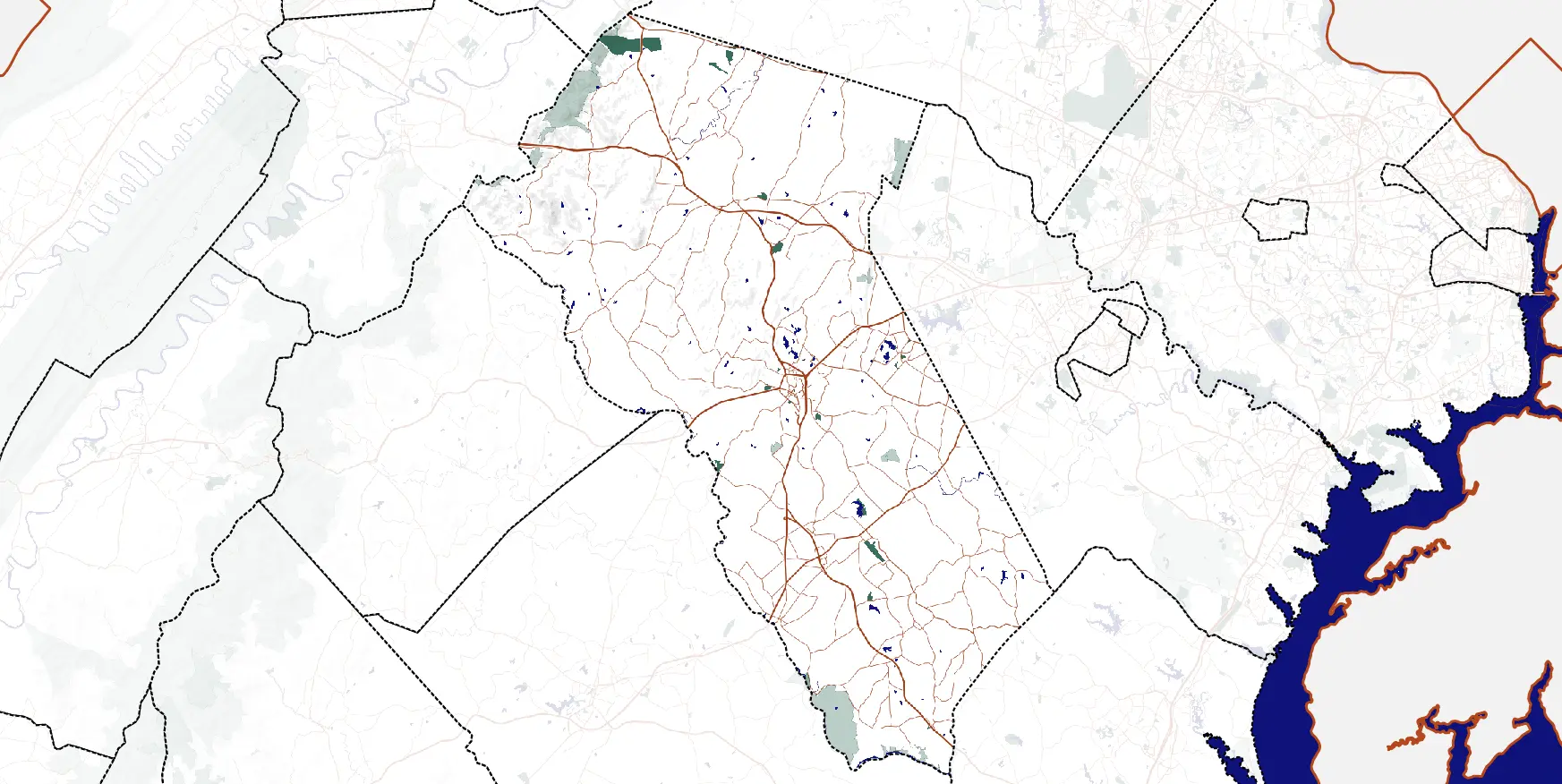
Median Household Income: $83,877
Historical Insights: Fauquier County’s history dates back to the mid-18th century when it was established. The county’s economy was historically rooted in agriculture, with tobacco as a key crop. Its fertile lands and proximity to Washington, D.C., and Northern Virginia have long made it an attractive location for farming and trade.
Economic Evolution: Fauquier County’s economic evolution has seen it transition from an agrarian society to a more diversified and modern economy. The county’s location, offering a mix of countryside living and proximity to urban centers, has attracted new residents and businesses. The equestrian industry has thrived, and the county’s economic base now includes technology, healthcare, and professional services. With a median household income of $83,877, Fauquier County represents a successful blend of rural charm and economic progress.
Current Economic Landscape: In the present economic landscape, Fauquier County continues to prosper as a community that values its historical and cultural heritage while embracing economic growth. The county’s dedication to land preservation, along with its thriving equestrian culture and expanding industries, has created a dynamic and attractive community. Fauquier County exemplifies how a historically rich area can adapt and thrive in the modern era, offering a high quality of life for its residents.
5. Prince William County

Median Household Income: $91,098
Historical Insights: Prince William County, founded in the late 17th century, has a rich history rooted in agriculture and commerce. The county’s location along the Potomac River made it an important hub for trade and transportation. Agriculture, particularly tobacco cultivation, played a significant role in its early economic development.
Economic Evolution: Prince William County’s economic evolution has witnessed a transformation from an agrarian society to a diversified modern economy. The county’s strategic location between Washington, D.C., and Northern Virginia has made it an attractive destination for businesses and residents. Today, it hosts a broad range of industries, including technology, healthcare, government, and professional services. With a median household income of $91,098, Prince William County showcases a harmonious blend of historical significance and contemporary prosperity.
Current Economic Landscape: In the present economic landscape, Prince William County continues to thrive as a dynamic community. The county’s commitment to quality education, access to a broad range of services, and its proximity to major employment centers have all contributed to its vibrancy. Residents enjoy a blend of suburban living and urban opportunities, making Prince William County an appealing place for professionals and families alike. The county stands as a testament to how a historically agricultural area can adapt and flourish in the modern era.
4. Stafford County
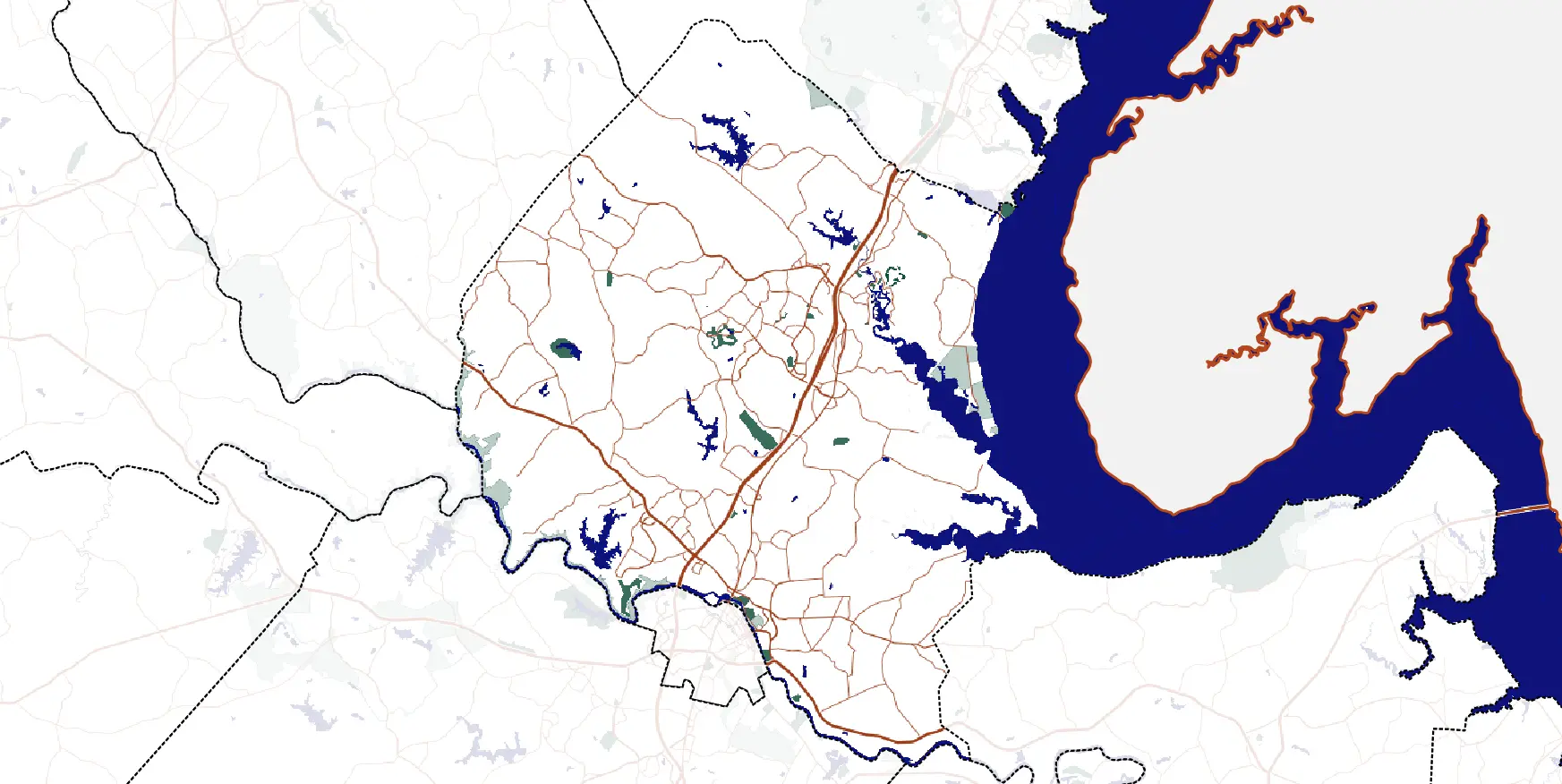
Median Household Income: $93,065
Historical Insights: Stafford County’s history traces back to the early 17th century when it was founded. Agriculture, with a focus on tobacco farming, was a cornerstone of its early economy. Its location along the Potomac River contributed to its significance in trade and commerce.
Economic Evolution: Stafford County’s economic evolution has witnessed a transition from an agricultural-based society to a more diversified landscape. The presence of major military installations, including Marine Corps Base Quantico, played a pivotal role in the county’s development. It attracted defense-related industries and led to an expanding population. Additionally, Stafford’s strategic location along Interstate 95 positioned it as a commuter-friendly community with easy access to major employment hubs. With a median household income of $93,065, Stafford County represents a successful blend of historical heritage and modern economic progress.
Current Economic Landscape: In the present economic landscape, Stafford County continues to prosper as a community that values its historical significance while embracing economic growth. The county offers residents a combination of suburban living and economic opportunity, with a focus on education, healthcare, and public services. Stafford County exemplifies how historical areas can adapt to contemporary demands and offer a high quality of life for its residents.
3. Arlington County

Median Household Income: $94,880
Historical Insights: Arlington County’s history is closely tied to its role as an early center of transportation and trade. Established in the early 19th century, its location as a critical crossing point on the Potomac River contributed to its significance in trade and commerce. Additionally, the establishment of Arlington National Cemetery during the American Civil War has had a lasting impact on the county.
Economic Evolution: Arlington County’s economic evolution has witnessed a significant shift from its early role as a transportation hub to a thriving urban center. The proximity to the nation’s capital, Washington, D.C., led to the development of government-related industries, businesses, and a growing population. Today, the county boasts a dynamic economy with a focus on technology, research, and professional services. With a median household income of $94,880, Arlington County reflects the successful adaptation of a historically significant area to a modern, thriving urban landscape.
Current Economic Landscape: In the present economic landscape, Arlington County continues to thrive as a dynamic urban community. The county’s commitment to quality education, access to an array of services, and its strategic location near the nation’s capital have all contributed to its vibrancy. Residents enjoy the advantages of urban living while being surrounded by cultural, educational, and economic opportunities. Arlington County stands as a testament to how a historically significant area can adapt and flourish in the modern era, offering a high quality of life for its residents.
Please let me know if you would like me to continue with the descriptions for the remaining counties.
2. Fairfax County
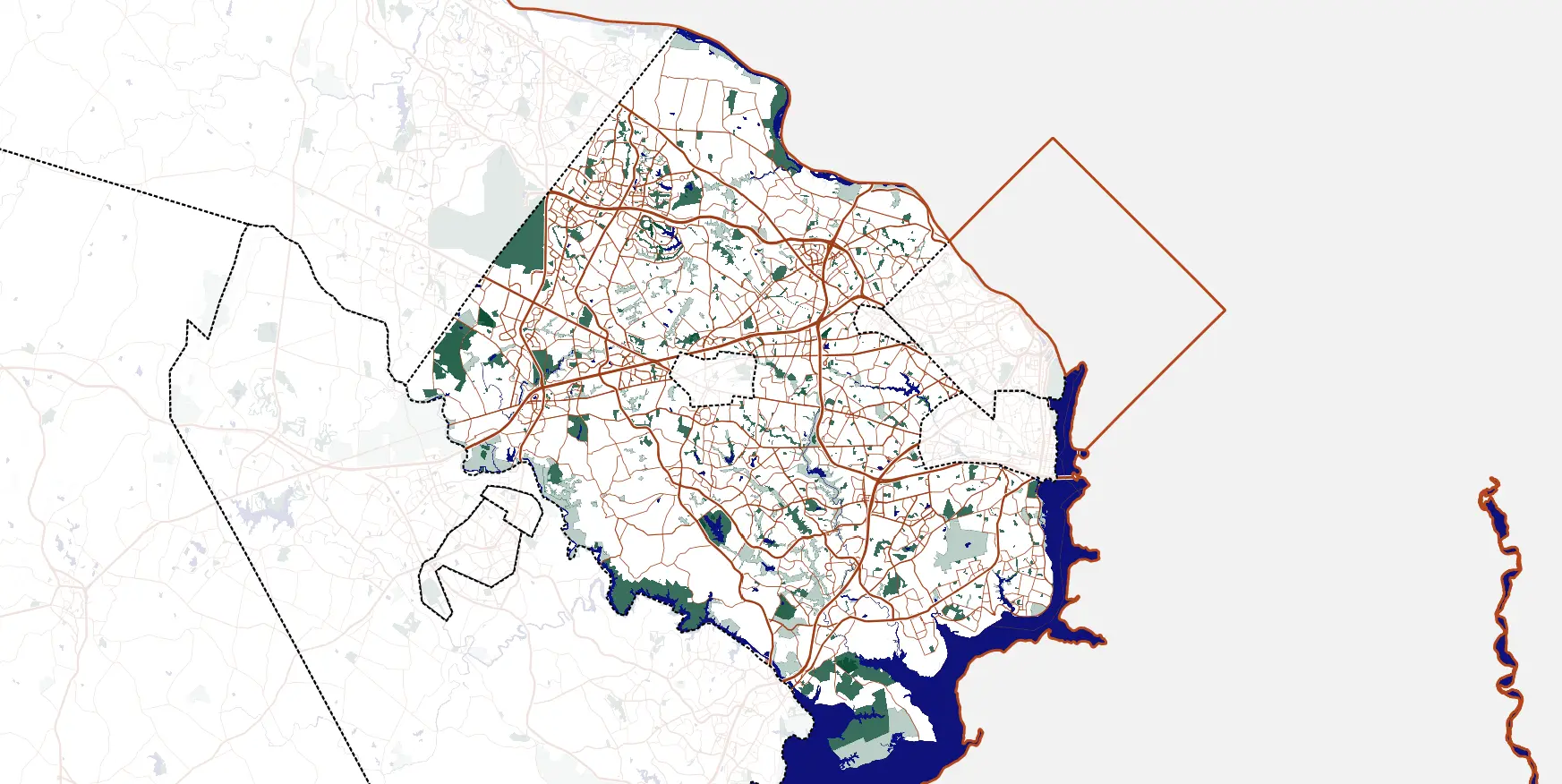
Median Household Income: $105,416
Historical Insights: Fairfax County’s history dates back to the early 18th century when it was founded. Agriculture, particularly tobacco farming, played a significant role in its early economy. The county’s strategic location near the nation’s capital and its proximity to trade routes facilitated growth in trade and commerce.
Economic Evolution: Fairfax County’s economic evolution has been a remarkable journey from its agrarian roots to becoming a vibrant economic hub. The county’s location near Washington, D.C. has attracted government agencies, businesses, and professionals. It is home to a diverse range of industries, including technology, defense, healthcare, and education. With a median household income of $105,416, Fairfax County represents the successful adaptation of a historically rich area to a modern, thriving urban landscape.
Current Economic Landscape: In the present economic landscape, Fairfax County continues to thrive as a dynamic community. The county’s commitment to quality education, accessibility to a wide range of services, and its strategic location near the nation’s capital have all contributed to its vibrancy. Residents enjoy the advantages of urban living while being surrounded by cultural, educational, and economic opportunities. Fairfax County stands as a testament to how a historically significant area can adapt and flourish in the modern era, offering a high quality of life for its residents.
1. Loudoun County

Median Household Income: $115,574
Historical Insights: Loudoun County’s history dates back to the early 18th century when it was founded. Its early economy was rooted in agriculture, with a focus on tobacco and grain farming. The county’s fertile soil and proximity to important transportation routes played a significant role in its economic development.
Economic Evolution: Loudoun County’s economic evolution has seen a remarkable shift from its agricultural past to becoming the wealthiest county in Virginia. The county’s strategic location near Washington, D.C. has attracted businesses, government contractors, and professionals. It has also become a hub for technology companies, data centers, and healthcare institutions. With a median household income of $115,574, Loudoun County represents a successful transformation from a rural landscape to a modern, thriving urban and suburban environment.
Current Economic Landscape: In the present economic landscape, Loudoun County continues to thrive as a dynamic community. The county’s commitment to quality education, access to an array of services, and its strategic location near the nation’s capital have all contributed to its vibrancy. Residents enjoy the advantages of urban and suburban living while being surrounded by cultural, educational, and economic opportunities. Loudoun County stands as a prime example of how a historically significant area can adapt to contemporary demands and offer a high quality of life for its residents.
These descriptions provide insight into the historical roots and economic transformation of the wealthiest counties in Virginia, showcasing their ability to adapt and thrive in the modern era. Each county’s unique history has contributed to its current economic landscape, resulting in prosperous and vibrant communities.
Conclusion
| RICHEST COUNTIES IN VIRGINIA | |
| COUNTY | MEDIAN HOUSEHOLD INCOME (2021) |
| Loudoun | $115,574 |
| Fairfax | $105,416 |
| Arlington | $94,880 |
| Stafford | $93,065 |
| Prince William | $91,098 |
| Fauquier | $83,877 |
| York | $81,055 |
| Goochland | $79,574 |
| Spotsylvania | $76,574 |
| Hanover | $76,425 |
| King George | $76,241 |
| James City | $73,903 |
| Powhatan | $73,593 |
| Clarke | $73,244 |
| Chesterfield | $71,321 |
Virginia’s richest counties offer a diverse range of lifestyles, from the historical charm of James City County to the urban vibrancy of Arlington and the pastoral beauty of Loudoun County. These counties are a testament to Virginia’s economic success and its ability to cater to a wide range of tastes and preferences.
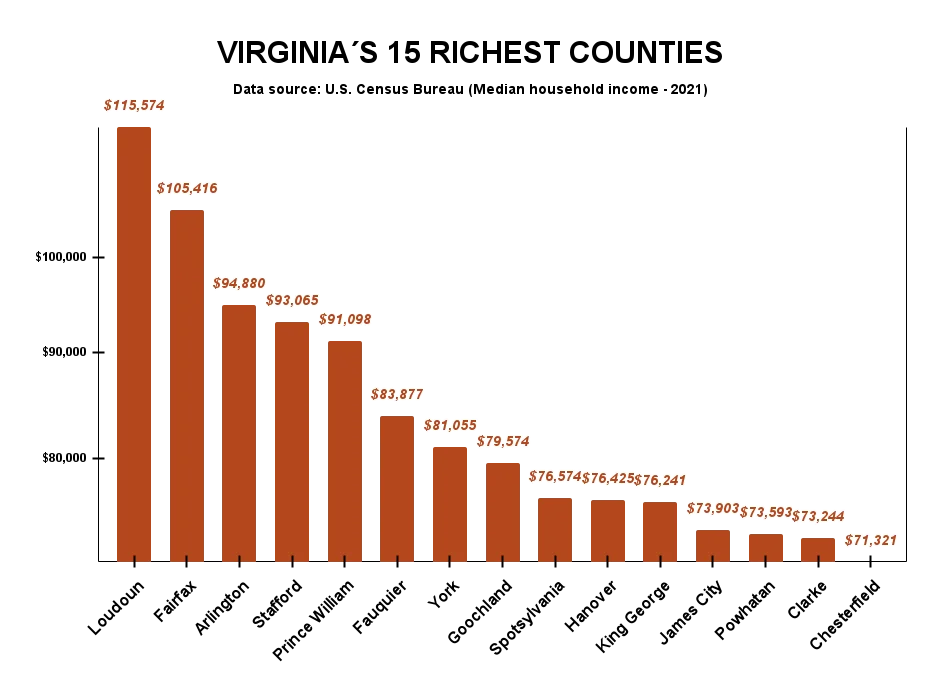
Rich in history, culture, and economic prosperity, these counties stand as beacons of success in the Old Dominion State. Whether you’re seeking a tranquil countryside retreat, a bustling urban lifestyle, or something in between, Virginia’s wealthiest counties have something to offer every discerning resident.






